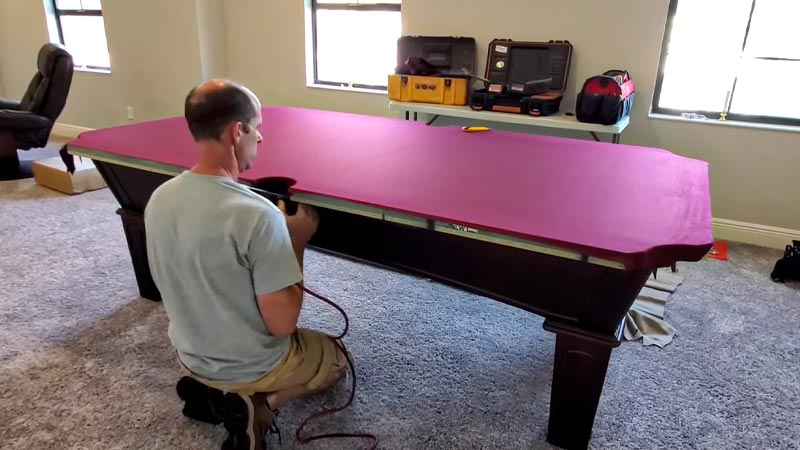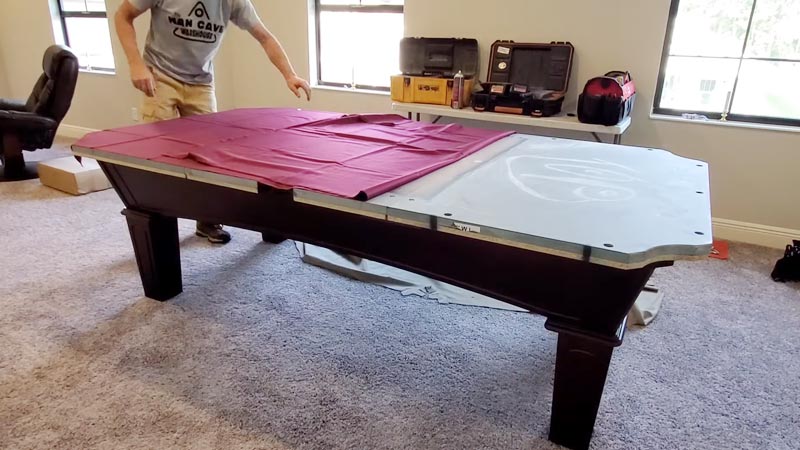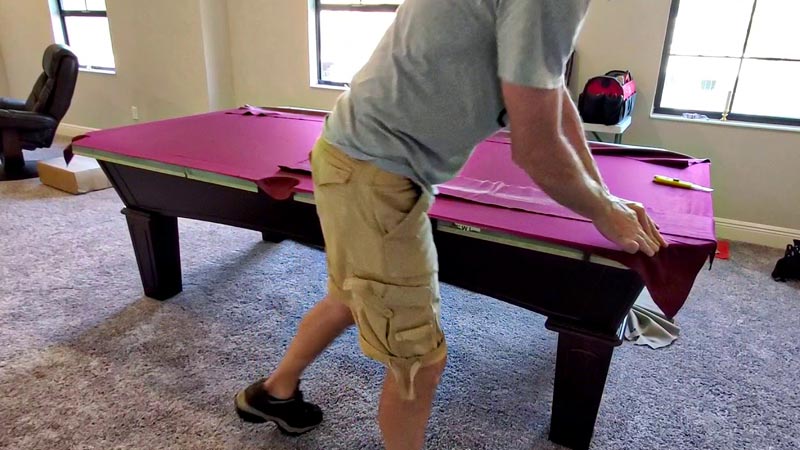When it comes to enjoying a game of pool or billiards, one crucial factor often overlooked is the quality of the pool table felt. The right choice of felt can significantly impact your gameplay and overall experience.
Whether you’re a seasoned player or just looking to upgrade your pool table, you likely have questions about selecting the perfect felt. In this blog post, we’ll explore choosing a pool table felt, providing valuable insights to help you make an informed decision.
We’ll also touch on related topics, including the cost of refelting your pool table and how to maintain the integrity of your clothes. Let’s dive in!
What Is Pool Table Felt?
A pool table felt, often referred to as “cloth,” is a specialized textile covering that is used to cover the playing surface of a pool table. It is an essential component of the game, as it directly influences the gameplay.
Typically made from a blend of wool and nylon or other synthetic materials, the pool table felt is designed to provide a smooth and consistent playing surface. It serves several important functions:
Smooth Playing Surface
The felt’s tightly woven fabric ensures a level and uniform surface, allowing the balls to roll smoothly and predictably.
Ball Control
The texture and friction of the felt help players control the movement of the cue ball, making it easier to perform precise shots.
Durability
High-quality pool table felt is durable and resistant to wear and tear, ensuring a longer lifespan for the table.
Aesthetics
Felt is available in various colors, allowing customization of the table’s appearance to match the decor of the room.
Regular maintenance, including cleaning and brushing, is necessary to maintain the integrity and longevity of the pool table felt.
What Is The Felt on a Pool Table Called?
The felt on a pool table is typically called “pool table cloth” or simply “table cloth.” It’s a specialized textile covering that is designed to provide a smooth and consistent playing surface for the game of pool or billiards.
This cloth is an essential component of the pool table, and it directly affects the gameplay by influencing the movement of the balls and the overall quality of play.
How to Put Felt on a Pool Table

Putting felt on a pool table is a meticulous process that requires care and precision to ensure a smooth and consistent playing surface. Here are step-by-step instructions on how to put felt on a pool table:
Tools and Materials Needed
- The new pool table felt
- Staple gun and staples
- Pool table brush
- Scissors or a utility knife
- Chalk
- A friend or helper (optional but recommended)
Prepare the Workspace
- Ensure you have a clean, well-lit workspace where you can lay out the new pool tablecloth.
- Remove any existing cloth and clean the slate playing surface thoroughly, removing any debris, old staples, or adhesive residue.
Lay Out the New Cloth
- Unroll the new pool tablecloth onto the table, positioning it so that it covers the entire playing surface.
- Allow the cloth to overhang the edges of the table evenly on all sides.
Center the Cloth
Carefully center the cloth on the table, making sure it is symmetrical and evenly positioned on all sides.
Smooth Out Wrinkles
Starting from the center, gently smooth out any wrinkles or bubbles in the cloth, working your way toward the edges. Be careful not to stretch the cloth too tightly.
Attach the Cloth
- Begin stapling the cloth to the slate playing surface along one side of the table, starting in the center and moving outward.
- Use a staple gun to attach the cloth to the slate. Space the staples about 6 to 8 inches apart.
- Pull the cloth taut as you staple it, but avoid overstretching, which can lead to uneven tension.
Repeat on the Opposite Side
After securing one side, move to the opposite side of the table and repeat the stapling process, ensuring the cloth remains centered and smooth.
Staple the Remaining Sides
Staple the cloth to the remaining two sides of the table, working your way from the center toward the corners.
Trim Excess Cloth
Once all sides are stapled, trim away the excess cloth using scissors or a utility knife. Leave a slight overhang of about 1/4 to 1/2 inch.
Fold and Staple Corners
Fold the excess cloth at each corner neatly and staple it securely. This will create neat, mitered corners.
Stretch and Check
Gently stretch and smooth out the cloth one final time to ensure it’s evenly tensioned and free of wrinkles.
Trim and Tuck Pockets
Trim the cloth around the pockets, leaving enough to tuck it neatly underneath the rails or into the pocket openings.
Chalk the Cloth
Use pool table chalk to lightly apply chalk to the surface of the cloth. This helps reduce friction and ensures a smooth roll of the balls.
Brush the Cloth
Use a pool table brush to brush the cloth in straight lines from the head of the table to the foot, ensuring a consistent nap.
Test and Enjoy
Test the table to ensure the balls roll smoothly and evenly across the cloth. If needed, make minor adjustments to the tension.
Properly installing pool table felt is a precise job that may require some experience and patience.
Choosing a Pool Table Felt for Your Table

Choosing the right pool table felt for your table is crucial as it directly impacts gameplay and the overall aesthetics of your pool room. Here are some factors to consider when selecting pool table felt:
Type of Material
Pool table cloth is typically made from a blend of wool and nylon, but you can also find options with other synthetic materials. Woolen cloth is slower and more durable, while worsted cloth (often a wool/nylon blend) is faster but may require more maintenance.
Durability
Consider the durability of the cloth, especially if your table gets a lot of use. Woolen cloth is generally more durable and can withstand heavy use over time.
Speed and Playability
The speed of the cloth affects gameplay. Worsted cloth is faster and offers a smoother playing surface, while woolen cloth is slower but provides more ball control. Choose based on your preferred style of play.
Color
Pool table cloth come in a variety of colors. Select a color that complements your room’s decor and personal preferences. Traditional green and blue are popular choices, but there are many color options available.
Brand and Quality
Choose a reputable brand known for producing high-quality pool table cloth. Quality cloth is more likely to provide consistent play and durability.
Tournament vs. Recreational Use
If you’re planning on using your table for tournaments or serious play, consider getting clothes that meet the specifications and standards of governing bodies like the World Pool-Billiard Association (WPA) or the Billiard Congress of America (BCA).
Maintenance Requirements
Different clothes may have varying maintenance needs. Some require more frequent brushing and maintenance to keep them in optimal condition, while others are more forgiving.
Budget
Prices for pool table cloth can vary widely. Set a budget and look for options within your price range that meet your needs.
Climate and Environment
Consider the climate and environment where your table is located. Humidity and temperature can affect the cloth, so choose a cloth that is suitable for your location.
Professional Installation
Installing pool table cloth can be challenging. If you’re not confident in your ability to do it yourself, consider hiring a professional installer to ensure the cloth is properly fitted and stretched.
Reviews and Recommendations
Read reviews and seek recommendations from experienced pool players or table owners to get insights into the performance and durability of specific cloth brands and models.
Remember that the choice of pool table cloth is a personal one, and it should align with your playing style, preferences, and budget.
Installation and Maintenance of a Pool Table Felt
Proper installation and maintenance of a pool table felt are crucial to ensure the longevity of the cloth and maintain a consistent and enjoyable playing experience.
Installation
To prepare and install a new pool table cloth, start by clearing the table of all accessories. Ensure the playing surface is clean and free from debris, old staples, or adhesive residue.
Lay out the new cloth, allowing it to overhang the edges evenly. Center it meticulously, then smooth out wrinkles from the center towards the edges, being cautious not to overstretch.
Attach the cloth by stapling it to the slate, starting from the center and moving outward. Maintain even tension, and repeat this process on the opposite side and the remaining two sides.
Trim excess cloth, leaving a slight overhang. Neatly fold and staple the corners, creating mitered corners. Stretch and check the cloth for even tension and no wrinkles.
Trim and tuck the cloth around the pockets and apply chalk to reduce friction. Finally, use a pool table brush to ensure a consistent nap from the head to the foot of the table. This meticulous process results in a well-felted pool table ready for enjoyable play.
Maintenance
Regular Brushing
Brush the cloth regularly before and after each game session to remove dust, chalk, and other debris. Brush in straight lines from the head of the table to the foot to maintain the cloth’s nap.
Vacuum Cleaning
Periodically use a pool table vacuum cleaner attachment to deep-clean the cloth and remove embedded dirt.
Avoid Spills and Stains
Prevent spills and stains by not placing drinks or food on the table. If a spill occurs, clean it immediately with a damp, clean cloth, and mild detergent if necessary.
Rotate Accessories
Rotate cue balls and other accessories regularly to prevent uneven wear on the cloth.
Monitor and Adjust Tension
Periodically check the tension of the cloth. If you notice any sags or wrinkles, you may need to adjust the staples to maintain even tension.
Professional Maintenance
Consider hiring a professional pool table technician for periodic maintenance and re-stretching of the cloth.
By following these installation and maintenance guidelines, you can ensure that your pool table felt remains in excellent condition, providing a consistent and enjoyable playing surface for years to come.
FAQs
How much does it cost to refelt a pool table?
One of the most common questions among pool table owners is the cost of refelting. We’ll break down the factors that influence the price and help you understand what to expect when considering a refelting project.
What is the best felt for a pool table?
With various materials and brands available, it can be challenging to determine the best felt for your specific needs. We’ll discuss the differences between woolen and worsted cloth, the importance of quality, and factors to consider when making your selection.
How to tighten felt on a pool table?
Over time, the felt on your pool table may become loose or develop wrinkles. We’ll provide step-by-step instructions on how to tighten the felt and maintain an even and taut playing surface.
What colors are available for pool table felt?
The aesthetics of your pool table matter too! We’ll explore the wide range of colors available, including classic greens and blues, as well as more unique options to match your room’s decor.
Should I consider tournament-grade cloth for my pool table?
If you’re a serious pool player or plan to host tournaments, you might wonder whether tournament-grade cloth is worth the investment. We’ll explain the differences between tournament and recreational clothes to help you decide which is right for you.
Wrapping Up
Selecting the ideal pool table felt is a decision that can significantly enhance your pool-playing experience. With the knowledge gained, you’ll be better equipped to choose the right felt material, color, and quality for your table.
Additionally, we’ve covered essential maintenance tips, including how to tighten loose felt. Remember that investing in quality felt and proper care will not only improve gameplay but also extend the lifespan of your pool table cloth.
So, whether you’re a casual player or a dedicated enthusiast, make an informed choice and enjoy countless hours of smooth, precise shots on your perfectly felted pool table. Best of luck.







